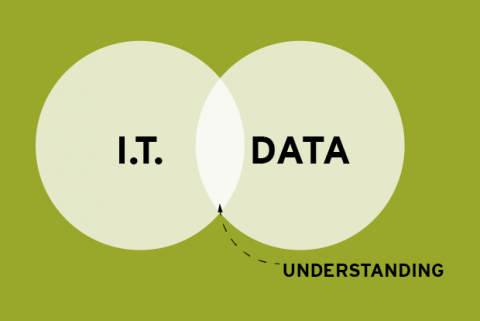Data analysis and traditional IT functions operate in separate silos in too many organizations. That means those organizations aren’t as effective as they could be, according to Krishna Venkatraman and Pamela Rice of online business lender OnDeck. Venkatraman is SVP of analytics, and Rice is SVP of technology. In part one of this two-part interview, they explained how OnDeck uses data and software to make better lending decisions than humans could. In part two, they talk about how to break down the divisions between data and IT.

The Enterprisers Project (TEP): You talk about breaking down the silos between data and technology. Since the collection and analysis of data are typically technological functions, can you tell me about the silos you see between data management and IT?
 Venkatraman: Data collection can easily become a mechanical exercise, unless it is animated by a purpose. With open-air desks within just a few feet of one another, OnDeck’s data and technology teams work together in every part of the business. Together, we identify opportunities to improve decisions and operations through data insights. We then use these learnings to drive our strategy to collect, aggregate, and organize our data. The data team focuses on machine learning and analytics software services that provide intelligence at every decision point of our customer funnel, collaborating with teams from marketing to customer service. The technology team builds the underlying transactional systems, decision workflows and user experiences that carry customers through our product.
Venkatraman: Data collection can easily become a mechanical exercise, unless it is animated by a purpose. With open-air desks within just a few feet of one another, OnDeck’s data and technology teams work together in every part of the business. Together, we identify opportunities to improve decisions and operations through data insights. We then use these learnings to drive our strategy to collect, aggregate, and organize our data. The data team focuses on machine learning and analytics software services that provide intelligence at every decision point of our customer funnel, collaborating with teams from marketing to customer service. The technology team builds the underlying transactional systems, decision workflows and user experiences that carry customers through our product.
As a company, we focus on the respective strengths of the data team and the technology team that complement one another. For example, data teams need to test and iterate rapidly to refine their initial hypotheses, whereas tech teams work best with a well-documented and validated road map. Finding where the two teams meet in the middle is what makes our jobs exciting. Combining seemingly opposing aspects of a workplace environment can sometimes make for interesting times, but we find that this results in a healthier, more open culture that spreads to every division of the company.
TEP: More data of all kinds is available today than ever before, but not all of it is valuable. Some companies are struggling to determine which data they should pay attention to, store, and analyze, and which data is not that useful. Has OnDeck faced challenges like these? How do you deal with the threat of data overload?
Venkatraman: In the future, we will look back and wonder, “How did we get by with so little data?” I think we are just getting started in thinking about architectures for learning systems that “automagically” get better with more data. Most companies, save for the select few web-scale companies, truly don’t have a challenge with collecting and storing data; they just have a challenge in quantifying the value of the data and as such in justifying the investment.
This is partially due to organizational silos. Different functions often make investment decisions in isolation and, when it comes to data, this can hurt. For instance, data that is useful for marketing decisions is often useful for sales and customer service as well. Taken together, the case for making the investment may be very strong, but it’s easy for each of the siloed functions to come to the opposite conclusion.
Another reason why data can seem overwhelming for companies is that many of them have been trained to believe that if they simply start collecting data, insights and value will automatically follow in the not too distant future. In fact, the opposite is true. It is very important for the company to have a set of specific objectives – be they strategic or tactical – that inform the data strategy and investment decisions. If you don’t have these objectives, the road from investment to value can become a maze of exploratory paths leading to nowhere.
TEP: Being a data scientist is apparently the hottest job of 2016, and the talent shortage may be more severe in this area than any other. In a company that is so data-driven, how do you recruit and retain the data science talent you need?
Venkatraman: There is a lot of hype around the deficit of data scientists for hire, but I believe that you do not need an army of data scientists to make meaningful discoveries. With the tools and systems available today, it is possible for even one or two talented, motivated data scientists to create game-changing innovation. The key is to hire carefully, looking for strong training in quantitative disciplines (pick your favorite, it really does not matter), allied with the mindset of a restless tinkerer.
As a leader, I try to cultivate growth, autonomy, and teamwork throughout the company. This allows the company and data team to attract talent that wants to work with us and who has the same goals in mind. As a company, we aren’t just looking for people who have a degree in analytics or experience in the field. In fact, we have over 30 different graduate degrees on our team. A model data scientist is not just someone who can talk numbers all day long. As in any job, you need a wide variety of skills to be successful.
TEP: What advice would you give other CIOs and tech leaders about working with data and technology?
Venkatraman: Think bigger, be open to change, tolerate more failure, and be clear about how you measure success. Should you be happy if three out of 10 data science experiments succeed? Five out to 10? Too often, companies don’t want to leave the comfort of a well-worn path, but if you invest in data you have to also adopt a nonconformist mindset.
As a company, think about and plan for what you want to solve next year, not just what you plan to accomplish next month. At the same time, it is perfectly acceptable to be ambitious, but do fewer things. Often, companies try too many things and spread themselves too thin. With too many balls thrown into the air, predictably, some may fall to the ground.
 Rice: It’s sometimes easy for CIOs to focus on either the what (architecture, applications) or the how (cross-functional groups with shared goals). However, I’ve found it incredibly valuable to give as much attention to the people side of the equation as I do the systems side in order to build long-term sustainability of systems and high growth potential for individuals and teams.
Rice: It’s sometimes easy for CIOs to focus on either the what (architecture, applications) or the how (cross-functional groups with shared goals). However, I’ve found it incredibly valuable to give as much attention to the people side of the equation as I do the systems side in order to build long-term sustainability of systems and high growth potential for individuals and teams.
The way I look at it, there are four components to leveraging technology, data, and intelligence successfully. First, your technology platforms need an architecture that allows a singular purpose and streamlines information, events and intelligence sharing. They need to be able to scale (be built with more than duct tape and bubble gum), have real-time monitoring, and have business metrics readily available once deployed.
Second, the well-architected platform needs to be able to leverage models as services. These models allow your platform to have layers of intelligence, such as probability to pay, smart dialer routing, and credit decisions. Third, these systems and models need to have well-defined working relationships with one another, with the same stable engineering practices applied. This allows a company’s tech platforms to be tweaked over time and back tested with data that increases the reliability of the decisions.
Lastly, the more teams across disciplines can share purpose and goals that align towards the customer, the more you get away from employees getting tied to specific platforms and technological systems. A certain magic occurs when multi-disciplined teams create something much better together than they could have alone, providing a positive impact on the entire business. This magic is what we shoot for at OnDeck.




